JHP Newsletter - 2009, No. 5, 5 October
Greetings from Glacier National Park, Montana. A lot has happened since the last Newsletter, so this will be a long one, and I'll save some things for the next Newsletter too.
Equipment: Canon EOS 1Ds Mk III
I finally purchased a Canon EOS 1Ds Mk III body to replace my Canon EOS 1Ds Mk II as my primary landscape body. I purchased it used on eBay, and the "mint condition" body was practically brand new! It's nice to have a 1Ds body with the same battery as my 1D body so I no longer have to deal with two different kinds of batteries. It's also nice to have the same control layout for both bodies, and I especially like the "Info" display on the rear LCD that mirrors the display on the top of the body. It's particularly useful when shooting landscapes because it's possible to see all of the camera settings without having to be able to see the top of the body which is sometimes impossible when mounted on a tripod.
The images look great, and the 21.1MP files provide more information than the 16 MP files of the 1Ds Mk II. The slightly faster frame rate (5 vs. 4 fps) and larger buffer (12 vs. 11 RAW frames) make it better for a wildlife body than the 1Ds Mk II too.
Equipment: HiTech Neutral Density Filters
I started looking into neutral density (ND) filters after seeing some interesting results obtained with a Singh-Ray Vari-ND filter. It's a screw-on filter that provides anywhere from 2 to 8 stops of neutral density. Unfortunately, the filter is thick and extends 14.4mm (0.56 in) out from the front of the lens. Because I would also almost always be using a B+W F-Pro circular polarizer when using the Vari-ND, the stack would stick out 21.4mm (0.84 in) from the front of the lens! To test for vignetting, I made a paper ring to simulate the metal of the filters and tried it out first on my Canon EF 24-105mm f4L IS USM lens with a Canon EOS 1Ds Mk II (full frame) body. I could see the paper through the viewfinder if the lens was wider than about 55mm. That happened with both the native 77mm mount and on an 82mm step-up ring. (The Vari-ND is only available with 77mm and 82mm mounts.) Then I put the paper ring on my Canon TS-E 24mm f3.5L (Tilt/Shift) lens, and I could just barely see the ring with the 82mm step-up ring. Because I could see the ring through the viewfinder, I didn't have to take any test shots – the filter wouldn't be useful for my primary landscape lenses with a full-frame sensor. Singh-Ray also makes a Vari-N-Duo filter which is a combination of the Vari-ND filter and a polarizer, and it's thinner than the stacked filters, but it's only available with a 77mm mount, so it couldn't be used with the Canon EF 16-35mm f2.8L II USM or TS-E 24mm f3.5L II – two lenses on my want list.
Instead I got 4x4" (100x100mm) HiTech 2-, 3-, and 4-stop ND filters that are compatible with the Cokin Z-Pro filter holder. Used in combination, I could also obtain 5, 6, 7, and 9 stops of ND if desired. The HiTech filters are resin filters, and they're cheaper than Lee filters which I also considered.
My intention was to do away with my current screw-on Hoya 3-stop ND filters and use only the square resin filters. However, the HiTech filters, especially the 3-stop that I have, impart an odd magenta cast to the image that can't be completely corrected by adjusting the white balance. I've found that by using a the 3-stop Hoya ND filter, which imparts a subtle "brown" cast, and then the HiTech ND filter, I have an image that I can work with.
Travel: Banff and Jasper National Parks, Canada
Way back in June, we were heading north through Canada on our way to Alaska. We spent nine days in Banff National Park at the end of June. We started in the southern part of the park and photographed some very cooperative bighorn sheep near Minnewanka Lake, including the lamb shown below left. Then we moved up to Lake Louise in the center of the park for a while where we photographed the iconic Lake Louise and also nearby Moraine Lake which I prefer more. Then we stayed at Waterfowl Lake Campground so we could photograph iconic Peyto Lake.
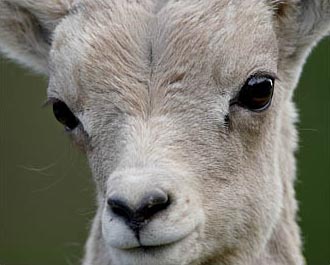
1/125 sec, f8, ISO 400
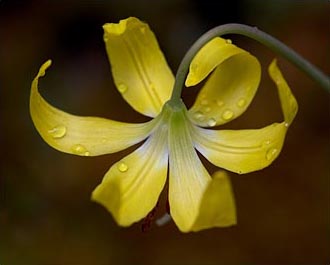
1/20 sec, f8, ISO 100
We stayed in Jasper National Park for seven days, and camped first at Wilcox Creek just across the border from Banff National Park. While there, we had fun photographing along Nigel Creek in Banff National Park. There was a large area with glacier lilies (above right) near some wonderful cascades and potholes. We also really enjoyed photographing Tangle Falls (below left) in Jasper National Park. Then we moved up to Whistler's Campground near the Jasper townsite. Elk cows, calves, and young bulls were hanging out in the campground, and that's where I got my best shot of an elk during our stay (below right).
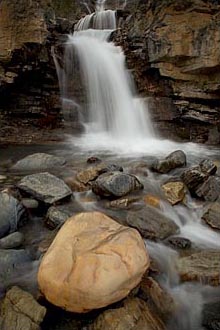
1/20 sec, f8, ISO 100
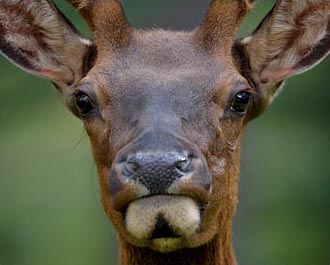
1/60 sec, f5.6, ISO 400
Travel: The Alaska Highway
First stop along the Alaska Highway was Stone Mountain Provincial Park in British Columbia. We were hoping to photograph the stone sheep that live there, but there was lots of construction to lay a fiber optic cable near their favorite areas, and we didn't get any great shots of the sheep. We did have good encounters with woodland caribou and moose, though.
Then we went to Muncho Lake Provincial Park in British Columbia, where we did have some great photo ops for stone sheep. The best was of two lambs standing atop a berm by a stream (below left).
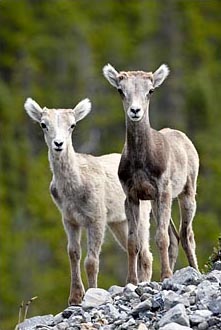
British Columbia, Canada
1/125 sec, f11, ISO 400
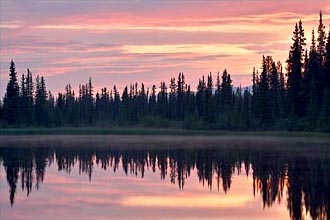
1.5, 0.7, & 0.3 sec, f11, ISO 100
We boondocked at scenic Salmo Lake just off the Alaska Highway in the Yukon Territory. ("Boondocking" is camping at an unofficial camping spot, usually out in the boonies.) We arrived late in the day (about 9:00 pm), but still in plenty of time to photograph sunset which was around 11:00. The cloud layer didn't light up like I had wanted it to, and most of the sky remained a dull gray. However, the clouds right near the horizon had some great color, and the line of trees bracketed it nicely (above right). The image was created by combining three exposures in Photoshop.
Travel: Alaska
We reached Alaska on July 22nd, and headed down to Valdez. Jan showed me a great place to photograph just to the northwest of town, and we had fun photographing the waterfalls and cascades along Mineral Creek. We left Valdez and boondocked near Worthington Glacier, just to the northeast of Valdez. The spot looked suspicious when we pulled in, but it was flat and far from the road so we set up camp. The next evening, I was looking at a local map of the area, and discovered that we were parked right on a grass strip runway. I don't think anyone had landed there in more than a year because the brush had started to reclaim the runway, but every time a big truck went by on the road, we wondered if it was an airplane, so we moved the RV off the runway and onto the adjacent parking area. :) From our boondocking spot, we made a couple of excursions back over Thompson Pass to photograph the waterfalls, including Bridal Veil Falls (below left). I used a polarizer to minimize the reflections off the wet rocks, then converted the image to black-and-white in Photoshop.
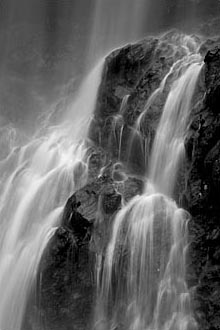
100-400 (at 150mm), polarizer,
1/4 sec, f16, ISO 100

1/750 sec, f8, ISO 320
Then we went to stay at some photographer friends in Wasilla on July 28th. They're conveniently located near Hatcher Pass, and we went up there several times. On one trip, we spent a lot of time photographing some collared pika gathering food for the winter (above right). They are also close to Palmer, and the visitor center there has a wonderful garden of mostly native plants. We spent one overcast morning there photographing the flowers, and my favorite image from there is of a pink lupine taken from almost directly above the columnar cluster (below left). Our friends are avid bird photographers, and they have several "magic logs" in their yard to attract birds. "Magic logs" are old snags that have strategically-placed holes in which to hide suet or seeds to attract the birds to a nice perch while not exposing the "bait." Several hairy woodpeckers (below center) frequented the "magic logs" as did downy woodpeckers, pine siskins, red-breasted nuthatches, and black-capped chickadees.
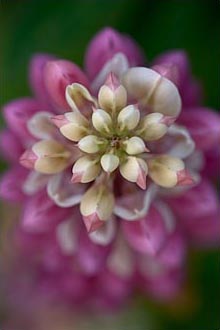
1/60 sec, f5.6, ISO 10
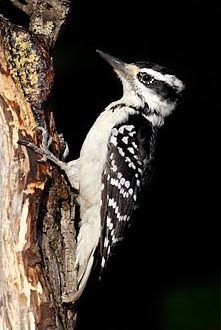
1/750 sec, f9.5, ISO 320

24-105 (at 92mm), polarizer,
2 sec, f16, ISO 100
We went down to Anchorage for a few days and photographed the cascades along Falls Creek in Chugach State Park south of Anchorage (above right). We also photographed some bull moose at and near the Ted Stevens Anchorage International Airport. Jan had told me that the airport was a good place to photograph moose, and I had been quite skeptical. We photographed a nice big bull on the airport property and two young bulls at nearby Kincaid Park.
We left Wasilla on August 18th and started to boondock on the Denali Highway. We spent three nice nights there and photographed Mt. McKinley, the highest point in North America at 20,320 ft (6194m). Usually, Mt. McKinley is only visible for one (1) of every five (5) days, and we were able to photograph it in the clear two days in a row – unheard of!
Travel: Denali National Park and Preserve
On August 22nd, we started our nine-night stay in Denali National Park. We started with three nights in the RV at Teklanika Campground, then spent five nights tent camping at Wonder Lake, and then one night back in the RV at Teklanika. Well, after the first night at Wonder Lake, Jan had had enough tent camping in the cold and went back to the RV. I was quite sad that I couldn't share the whole time out at Wonder Lake with her because that's one of my favorite places on Earth. The weather was especially good this time, and the animal encounters were fantastic, which added up to make it my best stay in Denali yet!
In order to minimize the amount of gear I had to schlep to the Wonder Lake Campground, I took a minimalist set of camera gear: Canon EOS 1Ds Mk III, 24 TS (Tilt/Shift), 24-105, 100-400, 500 f4, and 1.4x II tele-extender. I also only brought along CF cards to store images with no way to download. Just prior to the trip, I purchased three 16GB SanDisk Extreme III 30MB/s CF cards to add to my arsenal. They can record data from the 1Ds Mk III practically as fast as the 8GB SanDisk Extreme IV cards that I also had along, but they take about 1.3 times longer to download than the Extreme IVs.
While I was staying at Wonder Lake, Mt. McKinley, which is visible from the campground, was visible on four of the six days I was there which was great. Mt. McKinley is not only the highest point in North America, its 18,000 ft (5486m) rise from the surrounding plains is one of the greatest in the world – Mt. Everest, at 29,028 ft (8848m), rises a mere 11,000 ft (3353m) from the Tibetan Plateau. Plus, Mt. McKinley (20,320 ft or 6194m high) is surrounded by mountains in the Alaska Range that are "only" 10,000 to 15,000 ft (3050 to 4575m) high – no wonder the Athabascan Indians called it Denali, or "The Great One," or even "The Great One that laughs at the height of its brothers." It's an impressive mountain. In the image below left, Mt. McKinley was out at sunset, and this is what the view looks like from the campground in the fall with the tundra turning colors – spectacular!
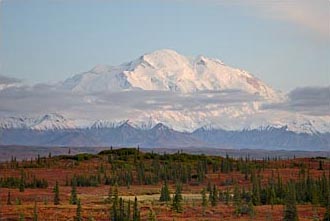
polarizer, 2-stop split ND,
1/250 sec, f8, ISO 100
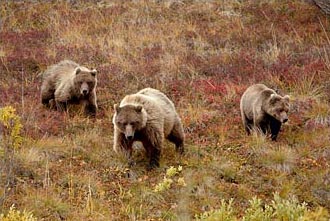
1/350 sec, f8, ISO 400
One of the challenges of photographing in Denali National Park is the bus system. No private vehicles are allowed into the heart of the park, and all vehicular travel is on the bus system. It's possible to get on and off the busses out in the park, but not too close to "dangerous wildlife." Grizzly bears count as "dangerous wildlife," and I photographed the sow with two cubs in the image above right from the bus. Fortunately, they were close to the road in a good setting, and the bus was in the right place at the right time.
Beaver are not considered "dangerous wildlife," and I was able to get dropped off very close to a beaver pond north of Wonder Lake. Two adults and a youngster were busy gathering food for the winter, and they didn't mind human visitors at the shore of their pond. I was quite amazed when one adult hauled a log that was about 5 ft (1.5m) long and 5 in (13cm) in diameter up the far side of the dam and over the top into the pond (below left)!

1/500 sec, f8, ISO 250
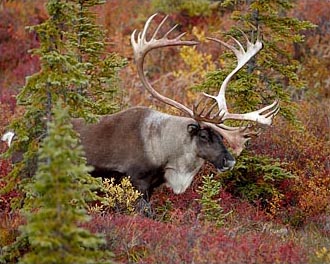
1/250 sec, f8, ISO 400
On the bus ride back from photographing the beavers, we stopped to photograph a nice porcupine caribou bull among the fall color. He had recently shed his velvet and his paddle was still bloody.
I got off the bus another day to photograph a moose cow and calf. They were just coming over a hill with colorful tundra, but I wasn't set up to photograph them until they reached a low meadow. They never posed "just right" before they got spooked and headed up over the hill and out of sight. However, in the image below left, the happy family is still looking pretty good.
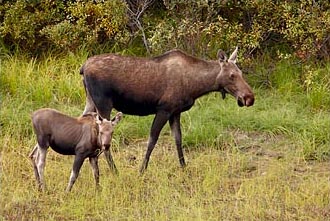
1/180 sec, f8, ISO 400

1/750 sec, f8, ISO 250
I started photographing the Dall sheep ewes and lambs, of which some are shown above right, from the bus, then got off the bus to continue photographing them after they had crossed the road and were heading up a hill, and also after a ranger had moved out of view. Some bus drivers are smart enough to bend the rules about "dangerous wildlife." :)
I'll tell you about the rest of our stay in Alaska and our return from Alaska next time.
Take care and happy shooting.
— James
James Hager Photography :: www.jameshagerphoto.com




